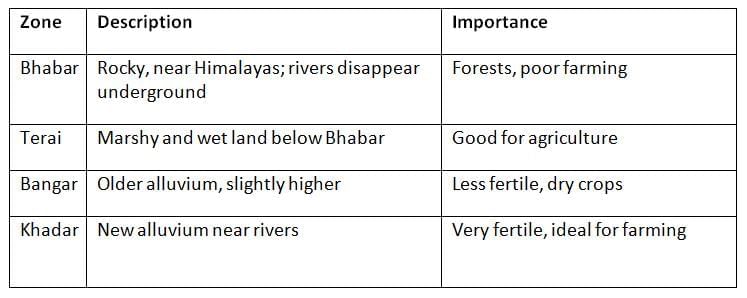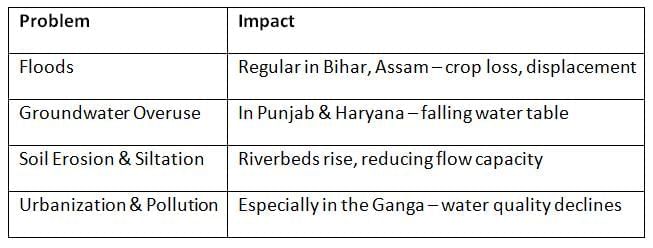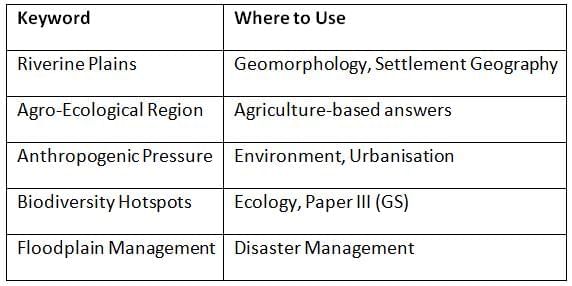UPSC Exam > UPSC Notes > Geography for UPSC CSE > Cheat Sheet: Indo-Gangetic Plains
Cheat Sheet: Indo-Gangetic Plains | Geography for UPSC CSE PDF Download
Introduction
- The Indo-Gangetic Plains are wide, flat lands formed by the deposits (alluvium) of the Indus, Ganga, and Brahmaputra rivers.
- Stretch across Punjab in the west to Assam in the east (around 2,400 km long).
- Located between the Himalayas (north) and the Peninsular Plateau (south).
- One of the most fertile and densely populated areas in the world.
Regional Divisions

Physiographic Zones

Prelims Tip: Khadar = New & fertile, Bangar = Old & less fertile.
Soils & Agriculture
- Soil Type: Alluvial soil – deep, rich in nutrients like potash and lime.
- Crops: Rice, wheat, sugarcane, pulses, jute, vegetables.
- Irrigation: Rivers, canals, tube wells.
Green Revolution began in Punjab, Haryana, and Western UP – boosted food grain production.
Population & Settlements
- Densely populated – cities like Delhi, Kanpur, Patna, Kolkata.
- High population pressure on land and resources.
- Region is the cultural and historical heart of India:
- Vedic Civilization, Maurya Empire, Gupta Empire
- Religious centers: Varanasi, Haridwar, Prayagraj
Rivers & Drainage

- Problems: River course changes (Kosi), floods, silt deposition, embankment failure
Major Issues

- Ganga Action Plan & Namami Gange launched to clean the river.
Biodiversity & Ecology
- Terai forests: Home to tigers, elephants, rhinos.
- Sundarbans: World’s largest mangrove forest; habitat of the Royal Bengal Tiger.
- Wetlands: Kanwar Lake (Bihar), Harike (Punjab) – rich in bird life.
UPSC Mains Keywords (Simple Usage)

The document Cheat Sheet: Indo-Gangetic Plains | Geography for UPSC CSE is a part of the UPSC Course Geography for UPSC CSE.
All you need of UPSC at this link: UPSC
|
175 videos|619 docs|192 tests
|
FAQs on Cheat Sheet: Indo-Gangetic Plains - Geography for UPSC CSE
| 1. What are the key regional divisions of the Indo-Gangetic Plains? |  |
Ans. The Indo-Gangetic Plains are generally divided into three main regions: the Punjab Plains, the Ganga Plains, and the Brahmaputra Plains. Each of these regions has distinct geographical features, climatic conditions, and agricultural practices. The Punjab Plains are known for their fertile alluvial soil, the Ganga Plains extend from the Ganges River and are vital for agriculture, while the Brahmaputra Plains are characterized by the river's flood plains and unique biodiversity.
| 2. What are the major physiographic zones within the Indo-Gangetic Plains? |  |
Ans. The Indo-Gangetic Plains consist of several physiographic zones, including the alluvial plains, river terraces, and floodplains. The alluvial plains are formed by sediment deposition from rivers, making them highly fertile. River terraces are elevated areas adjacent to rivers, while floodplains are low-lying areas that are prone to flooding, providing rich soil for agriculture.
| 3. How do soils and agriculture in the Indo-Gangetic Plains influence the economy? |  |
Ans. The soils in the Indo-Gangetic Plains are predominantly alluvial, which is highly fertile and supports extensive agricultural activities. This region is often referred to as the "granary of India" due to its high production of crops like wheat, rice, and pulses. Agriculture plays a crucial role in the economy, providing livelihoods for millions and contributing significantly to the country's food security.
| 4. What are the major rivers and drainage systems in the Indo-Gangetic Plains? |  |
Ans. The major rivers in the Indo-Gangetic Plains include the Ganges, Yamuna, Brahmaputra, and their tributaries. These rivers form an extensive drainage system that not only supports agriculture through irrigation but also plays a crucial role in the region's ecology and biodiversity. They are vital for transportation, water supply, and sustaining the livelihoods of millions of people.
| 5. What are the major environmental issues faced by the Indo-Gangetic Plains? |  |
Ans. The Indo-Gangetic Plains face several environmental issues, including soil degradation, water scarcity, and pollution. Intensive agricultural practices have led to soil depletion, while over-extraction of groundwater has resulted in declining water tables. Additionally, pollution from industrial and urban areas poses a significant threat to the region's biodiversity and overall ecological health.
Related Searches
















